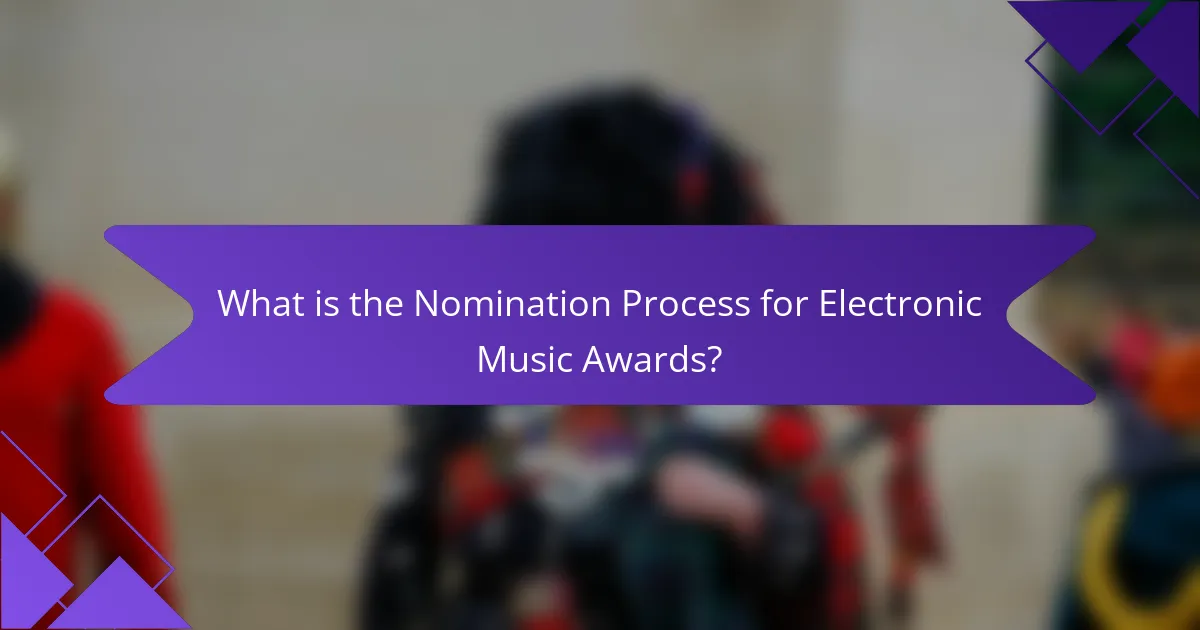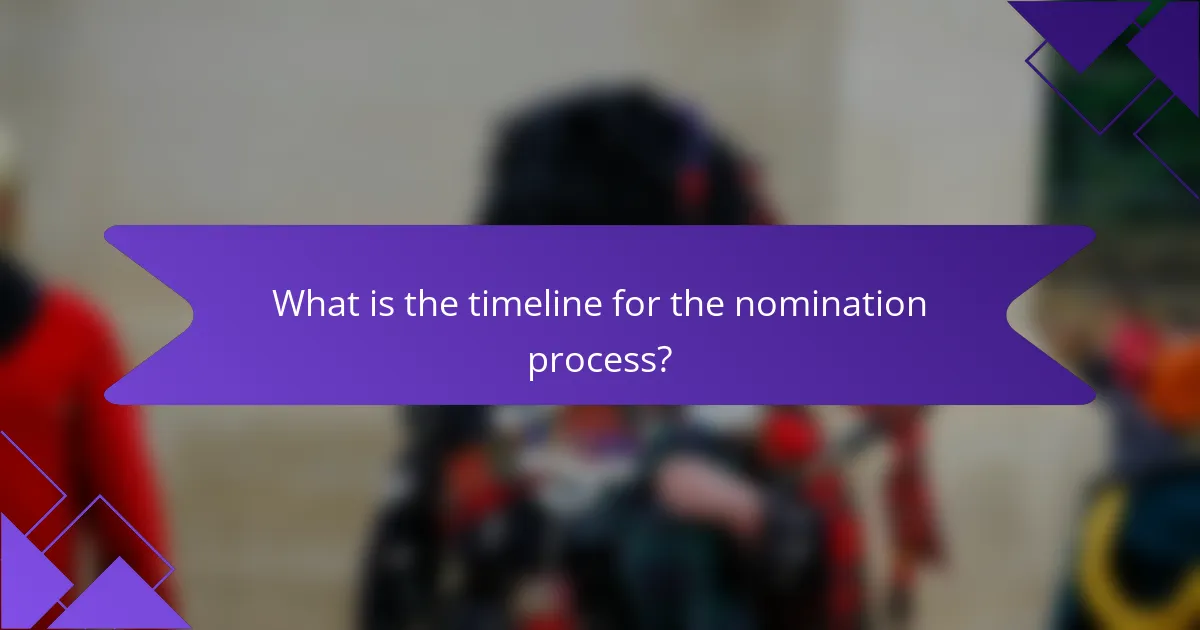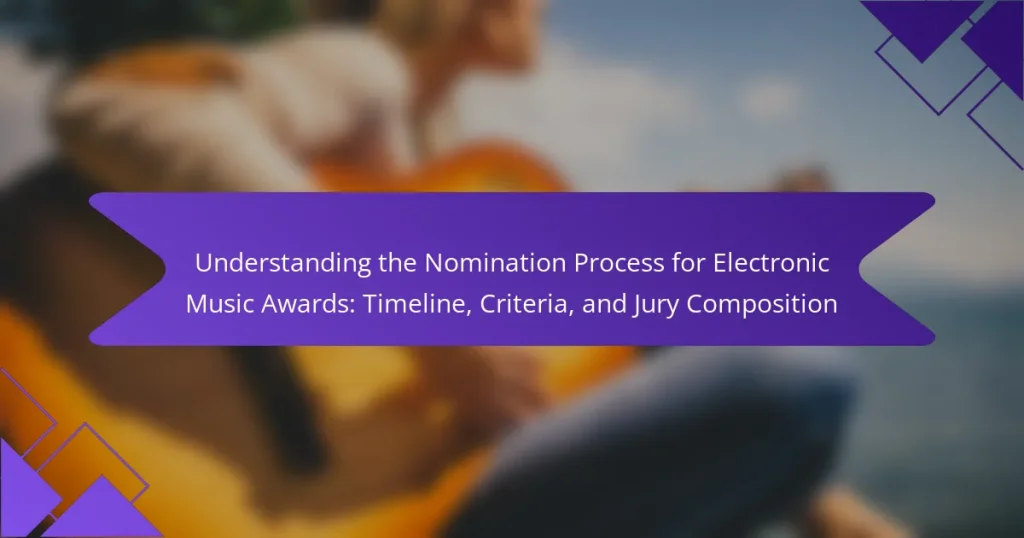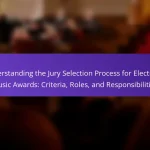The Electronic Music Awards nomination process involves a series of structured steps designed to ensure fairness and transparency. Eligible artists and tracks are submitted for consideration, and a selection committee composed of industry professionals evaluates these submissions based on creativity, impact, and popularity. The timeline spans several months, beginning with the announcement of the nomination period, followed by a review phase that culminates in the announcement of final nominees. Best practices for navigating this process include understanding eligibility criteria, preparing documentation in advance, and engaging with the community for support. This overview highlights the key aspects of the nomination process, including the timeline, evaluation criteria, and strategies for success.

What is the Nomination Process for Electronic Music Awards?
The nomination process for Electronic Music Awards involves several key steps. First, eligible artists and tracks are submitted for consideration. Nominations typically open several months before the awards ceremony. A selection committee reviews all submissions based on specific criteria. This committee often consists of industry professionals and experts. They evaluate submissions for creativity, impact, and popularity. The final nominees are announced publicly ahead of the awards event. Voter participation may also play a role in the final selection of winners.
How is the nomination process structured?
The nomination process for the Electronic Music Awards is structured in several key phases. Initially, eligible artists and tracks must meet specific criteria to qualify for nomination. A panel of industry experts reviews submissions to ensure compliance with these criteria. Following this, the panel votes on the nominations based on predetermined categories. The top selections from this vote become the official nominees. This structured approach ensures a fair and transparent selection process. The criteria include factors like artistic merit, innovation, and public appeal. Each year, the process may slightly adjust based on feedback and industry trends, maintaining relevance.
What are the key stages in the nomination process?
The key stages in the nomination process include proposal, review, and selection. In the proposal stage, eligible candidates are nominated by industry professionals or the public. The review stage involves a jury evaluating the nominees based on established criteria. Finally, the selection stage culminates in the announcement of the nominees for the awards. Each stage is essential for ensuring a fair and transparent process.
How does the timeline influence the nomination process?
The timeline significantly influences the nomination process by establishing deadlines for submissions and evaluations. Key dates dictate when artists can submit their work for consideration. This ensures that all entries are received in a timely manner for review. The timeline also outlines when the jury will convene to assess the nominations. Specific timeframes help maintain organization and efficiency in the process. Furthermore, adhering to a timeline allows for transparency and fairness in the nominations. It enables stakeholders to prepare adequately for each phase of the process. Overall, the timeline is crucial in structuring the nomination process effectively.
What criteria are used for nominations?
The criteria used for nominations in electronic music awards typically include artistic merit, innovation, and impact on the genre. Nominations often consider the quality of the music, originality, and the artist’s contribution to the electronic music scene. Additionally, commercial success and public recognition can play a role in the selection process. The eligibility period is usually defined, requiring works to be released within a specific timeframe. Voting by industry professionals and public polls may also influence the final nominees. These criteria ensure that a diverse range of talent is acknowledged and celebrated within the awards.
What are the essential eligibility requirements for nominees?
Nominees must have released music within the eligibility period. This period typically spans the last calendar year. They must also meet specific genre criteria relevant to electronic music. Additionally, nominees should have a minimum number of releases to qualify. This often includes singles, EPs, or albums. Furthermore, nominees must not have any disqualifying legal issues. These requirements ensure that all nominees are active and recognized in the electronic music community.
How are categories defined within the nomination criteria?
Categories within the nomination criteria are defined based on specific genres and contributions to electronic music. Each category reflects distinct aspects of the electronic music landscape. Categories may include best album, best artist, and best track. These definitions ensure clarity in the nomination process. The criteria are established by industry professionals and stakeholders. This structured approach allows for fair evaluation and recognition of talent. Each category has unique eligibility requirements. This ensures that nominees meet the standards set for their respective fields.
Who is involved in the nomination process?
The nomination process for the Electronic Music Awards involves several key participants. These include industry professionals, artists, and representatives from record labels. A jury panel typically evaluates the nominations. This panel consists of experts in electronic music. They assess submissions based on specific criteria. The process aims to ensure a fair representation of talent. Each nominee is usually selected based on their contributions to the genre. The involvement of diverse stakeholders enhances the credibility of the awards.
What roles do jurors play in the nomination process?
Jurors play a critical role in the nomination process for electronic music awards. They evaluate submitted works based on established criteria. Their assessments help determine which entries advance to the final nomination list. Jurors provide expert opinions, ensuring that selections reflect industry standards. They contribute to the integrity of the awards by maintaining objectivity. The composition of the jury often includes industry professionals with relevant experience. Their collective judgment influences the recognition of deserving artists and projects. This process ensures that nominations are credible and representative of the electronic music landscape.
How is the jury composition determined?
The jury composition is determined by a selection process that includes industry professionals. These professionals are typically chosen based on their expertise and experience in electronic music. The selection criteria may involve evaluating their contributions to the genre and their recognition within the community. Additionally, diversity in representation is often a goal to ensure a broad range of perspectives. The final jury is usually confirmed by the organizing committee of the awards. This process helps maintain the integrity and credibility of the awards.
How does the nomination process impact artists and the electronic music community?
The nomination process significantly impacts artists and the electronic music community by providing recognition and validation. When artists are nominated for awards, it enhances their visibility in the industry. Increased visibility can lead to more opportunities for collaborations and performances.
Furthermore, nominations can boost an artist’s credibility among peers and fans. This credibility often translates into increased sales and streaming of their music. The electronic music community benefits from a nomination process by fostering competition and innovation.
Recognition of talent encourages artists to push creative boundaries. Increased attention on nominated artists can also elevate the entire genre’s profile. Overall, the nomination process plays a crucial role in shaping the careers of artists and the growth of the electronic music community.
What are the benefits of being nominated for an award?
Being nominated for an award enhances visibility and credibility. It signifies recognition of talent and effort in a specific field. This acknowledgment can lead to increased opportunities for collaboration and networking. Additionally, nominations often attract media attention, further promoting the nominee’s work. According to a study by the National Endowment for the Arts, award nominations can boost an artist’s career trajectory significantly. Furthermore, being nominated can instill a sense of motivation and validation, encouraging continued excellence in one’s craft.
How can artists leverage nominations for their careers?
Artists can leverage nominations to enhance their careers significantly. Nominations provide recognition and validation in the competitive music industry. They can increase an artist’s visibility and credibility among peers and potential fans. This visibility often leads to more opportunities for performances and collaborations. Furthermore, nominations can attract media attention, resulting in interviews and features that promote the artist’s work. Statistics show that artists with nominations often see an increase in streaming numbers and sales. For instance, a study by the Recording Academy found that Grammy-nominated artists experience a 30% boost in album sales. Overall, nominations can serve as a powerful marketing tool for artists, helping to elevate their careers.

What is the timeline for the nomination process?
The timeline for the nomination process typically spans several months. It begins with the announcement of the nomination period, which usually occurs in early spring. Nominations are then accepted for a specified duration, often lasting between four to six weeks. After this period, a review phase takes place where submitted nominations are evaluated. This evaluation phase can last several weeks, culminating in the final list of nominees. The announcement of the nominees generally occurs in late spring or early summer. The entire process is designed to ensure thorough consideration and transparency in selecting candidates for the awards.
When do nominations typically open and close?
Nominations for Electronic Music Awards typically open in early January and close in mid-February. This timeframe allows artists and producers to submit their work for consideration. The specific dates may vary each year, but this general window has been consistent. For instance, in 2023, nominations opened on January 10 and closed on February 15. This schedule is designed to give ample time for submissions while ensuring a timely evaluation process.
How long is the review period for nominations?
The review period for nominations typically lasts four to six weeks. This timeframe allows the jury sufficient time to evaluate each nomination thoroughly. The process involves assessing various criteria to ensure fairness and transparency. During this period, nominees may be contacted for additional information if needed. The timeline is crucial for maintaining the integrity of the awards. The specific duration can vary depending on the number of nominations received.
What key dates should artists and fans be aware of?
Key dates for artists and fans regarding the Electronic Music Awards include the nomination submission deadline, which is typically set for early June. The announcement of nominees usually occurs in mid-July. Voting by the public often begins shortly after the nominees are announced and lasts for several weeks. The winners are typically revealed at the awards ceremony, which is usually held in late August. These dates can vary yearly, so it’s essential to check the official Electronic Music Awards website for the most current information.
What happens after the nomination period ends?
After the nomination period ends, the submitted nominations are reviewed by the jury. The jury evaluates each nomination based on established criteria. This evaluation leads to the selection of finalists for the awards. Finalists are typically announced publicly shortly after the review process concludes. The announcement often generates excitement and anticipation within the electronic music community. Following the announcement, the voting process may commence for the public or jury to select winners. The winners are then revealed during the awards ceremony. This timeline ensures transparency and engagement with the audience.
How are nominees announced to the public?
Nominees are announced to the public through a formal press release. This release is typically distributed via various media channels. Social media platforms also play a significant role in the announcement. The announcement often includes details about the nominees and categories. It may also feature quotes from industry experts or organizers. This method ensures wide visibility and engagement. Public interest is generated through promotional campaigns surrounding the announcement. The press release is usually timed to maximize media coverage and audience reach.
What steps follow the announcement of nominees?
After the announcement of nominees, voting begins. Voters include industry professionals and fans. They cast their votes for their preferred nominees. The voting period typically lasts several weeks. After voting concludes, the votes are tallied. The results are then verified for accuracy. Finally, winners are announced at a designated awards ceremony. This process ensures transparency and fairness in the selection of winners.

What are the best practices for navigating the nomination process?
Best practices for navigating the nomination process include thorough research on eligibility criteria. Understanding the specific requirements for the Electronic Music Awards is essential. Prepare all necessary documentation in advance to avoid delays. Engage with the community to gain insights and support. Networking with industry professionals can enhance visibility. Follow submission guidelines meticulously to ensure compliance. Timely submissions increase the chances of consideration. Lastly, seek feedback on your nomination materials from trusted peers. These practices are crucial for a successful nomination experience.
How can artists prepare for the nomination process?
Artists can prepare for the nomination process by thoroughly researching the criteria and requirements for eligibility. Understanding the specific guidelines set by the award organization is crucial. Artists should curate their best work to showcase their talent effectively. This includes selecting tracks that align with the nomination criteria. Networking with industry professionals can also provide valuable insights and support. Engaging with fans and building a strong online presence can enhance visibility. Additionally, submitting materials ahead of deadlines ensures timely consideration. Following previous nominations and their outcomes can help refine strategies for future submissions.
What strategies can enhance an artist’s chances of being nominated?
Building a strong brand presence enhances an artist’s chances of being nominated. Artists should engage actively on social media platforms to reach a wider audience. Collaborating with established artists can also increase visibility. Consistently releasing high-quality music is crucial for maintaining relevance. Participating in industry events can help build connections with key influencers. Submitting work to reputable music publications for reviews can boost credibility. Engaging with fans through live performances fosters loyalty and support. Lastly, ensuring that submissions meet all nomination criteria is essential for consideration.
How can artists effectively promote their nominations?
Artists can effectively promote their nominations by leveraging social media platforms. They should create engaging content that highlights their nomination and encourages followers to support them. Artists can also collaborate with influencers to reach a broader audience. Hosting virtual events or live streams can generate excitement and draw attention to their nomination. Additionally, sending out press releases to music blogs and local media can help spread the word. Engaging with fans through contests or giveaways related to the nomination can increase visibility. According to a study by the Pew Research Center, 72% of adults use social media, making it a powerful tool for promotion.
The main entity of the article is the nomination process for the Electronic Music Awards. The article provides a detailed overview of the key steps involved in this process, including eligibility criteria, the structured phases of proposal, review, and selection, as well as the important timeline and roles of jurors. It highlights the impact of nominations on artists and the electronic music community, emphasizing the benefits of recognition and visibility. Additionally, the article outlines best practices for artists to navigate the nomination process effectively.


